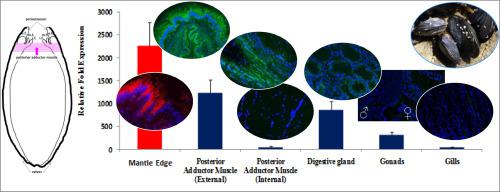当前位置:
X-MOL 学术
›
Comp. Biochem. Physiol. B Biochem. Mol. Biol.
›
论文详情
Our official English website, www.x-mol.net, welcomes your feedback! (Note: you will need to create a separate account there.)
New insights into the possible multiple roles of histidine-rich glycoprotein in blue mussels.
Comparative Biochemistry and Physiology B: Biochemistry & Molecular Biology ( IF 2.2 ) Pub Date : 2020-04-13 , DOI: 10.1016/j.cbpb.2020.110440 Susanna Sforzini 1 , Mohamed Banni 2 , Caterina Oliveri 3 , Michael N Moore 4 , Aldo Viarengo 1
Comparative Biochemistry and Physiology B: Biochemistry & Molecular Biology ( IF 2.2 ) Pub Date : 2020-04-13 , DOI: 10.1016/j.cbpb.2020.110440 Susanna Sforzini 1 , Mohamed Banni 2 , Caterina Oliveri 3 , Michael N Moore 4 , Aldo Viarengo 1
Affiliation

|
Histidine-rich Glycoprotein (HRG) is the most abundant protein in mussel haemolymph plasma. In this study, we determined by qRT-PCR and FISH analysis the tissues involved in HRG synthesis in Mytilus galloprovincialis. The relative HRG mRNA abundance in haemocytes, digestive gland, gills, gonads, posterior adductor muscle, and mantle edge was evaluated. Immunofluorescence analysis of HRG protein distribution in the whole mussel body was performed by a specific antibody. Our data showed the highest gene expression level of HRG in the mantle edge. In particular the outer fold of the mantle edge was shown to be the site that produced the highest amount of the protein. These data indicate a possible role of this Ca2++-binding protein in shell growth. HRG was also found in many other tissues and cells in contact with the haemolymph. This may be related to the immuno-responsive role of this protein. The presence of HRG in tissues related to the feeding pathways and mucous production could indicate the potential significance of this protein into mucus associated antimicrobial action. Overall, the results demonstrate that numerous mussel tissues are involved in HRG production, some of which can release the protein into the haemolymph and others into the extrapallial fluid. These data indicate that extrapallial (EP) protein and HRG are the same protein. An annual cycle survey showed a maximum HRG mRNA as well HRG protein production in mussel tissues in summer, a season in which the animals show the greatest growth, but are more likely to be exposed to microbial pathogens.
中文翻译:

富含组氨酸的糖蛋白在贻贝中可能扮演的多种角色的新见解。
富含组氨酸的糖蛋白(HRG)是贻贝血淋巴血浆中含量最丰富的蛋白。在这项研究中,我们通过qRT-PCR和FISH分析确定了Mytilus galloprovincialis中参与HRG合成的组织。评估了血细胞,消化腺,g,性腺,后内收肌和地幔边缘中相对HRG mRNA的丰度。通过特异性抗体对整个贻贝体内的HRG蛋白分布进行免疫荧光分析。我们的数据显示HRG在地幔边缘的最高基因表达水平。特别地,显示出地幔边缘的外褶是产生最大量蛋白质的部位。这些数据表明该Ca2 ++结合蛋白在壳生长中的可能作用。在与血淋巴接触的许多其他组织和细胞中也发现了HRG。这可能与该蛋白的免疫应答作用有关。组织中HRG的存在与进食途径和粘液产生有关,这可能表明该蛋白对粘液相关的抗菌作用具有潜在的意义。总体而言,结果表明,许多贻贝组织参与了HRG的产生,其中一些可以将蛋白质释放到血淋巴中,而另一些则释放到眼外液中。这些数据表明颅外(EP)蛋白和HRG是相同的蛋白。年度周期调查显示,夏季,贻贝组织中最大的HRG mRNA和HRG蛋白产量最高,在这个季节中,动物表现出最大的生长,但更可能暴露于微生物病原体。组织中HRG的存在与进食途径和粘液产生有关,这可能表明该蛋白对粘液相关的抗菌作用具有潜在的意义。总体而言,结果表明,许多贻贝组织参与了HRG的产生,其中一些可以将蛋白质释放到血淋巴中,而另一些则释放到眼外液中。这些数据表明颅外(EP)蛋白和HRG是相同的蛋白。年度周期调查显示,夏季,贻贝组织中最大的HRG mRNA和HRG蛋白产量最高,在这个季节中,动物表现出最大的生长,但更可能暴露于微生物病原体。组织中HRG的存在与进食途径和粘液产生有关,这可能表明该蛋白对粘液相关的抗菌作用具有潜在的意义。总体而言,结果表明,许多贻贝组织参与了HRG的产生,其中一些可以将蛋白质释放到血淋巴中,而另一些则释放到眼外液中。这些数据表明颅外(EP)蛋白和HRG是相同的蛋白。年度周期调查显示,夏季,贻贝组织中最大的HRG mRNA和HRG蛋白产量最高,在这个季节中,动物表现出最大的生长,但更可能暴露于微生物病原体。结果表明,许多贻贝组织参与了HRG的产生,其中一些可以将蛋白质释放到血淋巴中,而另一些则释放到眼外液中。这些数据表明颅外(EP)蛋白和HRG是相同的蛋白。年度周期调查显示,夏季,贻贝组织中最大的HRG mRNA和HRG蛋白产量最高,在这个季节中,动物表现出最大的生长,但更可能暴露于微生物病原体。结果表明,许多贻贝组织参与了HRG的产生,其中一些可以将蛋白质释放到血淋巴中,而另一些则释放到眼外液中。这些数据表明颅外(EP)蛋白和HRG是相同的蛋白。年度周期调查显示,夏季,贻贝组织中最大的HRG mRNA和HRG蛋白产量最高,在这个季节中,动物表现出最大的生长,但更可能暴露于微生物病原体。
更新日期:2020-04-20
中文翻译:

富含组氨酸的糖蛋白在贻贝中可能扮演的多种角色的新见解。
富含组氨酸的糖蛋白(HRG)是贻贝血淋巴血浆中含量最丰富的蛋白。在这项研究中,我们通过qRT-PCR和FISH分析确定了Mytilus galloprovincialis中参与HRG合成的组织。评估了血细胞,消化腺,g,性腺,后内收肌和地幔边缘中相对HRG mRNA的丰度。通过特异性抗体对整个贻贝体内的HRG蛋白分布进行免疫荧光分析。我们的数据显示HRG在地幔边缘的最高基因表达水平。特别地,显示出地幔边缘的外褶是产生最大量蛋白质的部位。这些数据表明该Ca2 ++结合蛋白在壳生长中的可能作用。在与血淋巴接触的许多其他组织和细胞中也发现了HRG。这可能与该蛋白的免疫应答作用有关。组织中HRG的存在与进食途径和粘液产生有关,这可能表明该蛋白对粘液相关的抗菌作用具有潜在的意义。总体而言,结果表明,许多贻贝组织参与了HRG的产生,其中一些可以将蛋白质释放到血淋巴中,而另一些则释放到眼外液中。这些数据表明颅外(EP)蛋白和HRG是相同的蛋白。年度周期调查显示,夏季,贻贝组织中最大的HRG mRNA和HRG蛋白产量最高,在这个季节中,动物表现出最大的生长,但更可能暴露于微生物病原体。组织中HRG的存在与进食途径和粘液产生有关,这可能表明该蛋白对粘液相关的抗菌作用具有潜在的意义。总体而言,结果表明,许多贻贝组织参与了HRG的产生,其中一些可以将蛋白质释放到血淋巴中,而另一些则释放到眼外液中。这些数据表明颅外(EP)蛋白和HRG是相同的蛋白。年度周期调查显示,夏季,贻贝组织中最大的HRG mRNA和HRG蛋白产量最高,在这个季节中,动物表现出最大的生长,但更可能暴露于微生物病原体。组织中HRG的存在与进食途径和粘液产生有关,这可能表明该蛋白对粘液相关的抗菌作用具有潜在的意义。总体而言,结果表明,许多贻贝组织参与了HRG的产生,其中一些可以将蛋白质释放到血淋巴中,而另一些则释放到眼外液中。这些数据表明颅外(EP)蛋白和HRG是相同的蛋白。年度周期调查显示,夏季,贻贝组织中最大的HRG mRNA和HRG蛋白产量最高,在这个季节中,动物表现出最大的生长,但更可能暴露于微生物病原体。结果表明,许多贻贝组织参与了HRG的产生,其中一些可以将蛋白质释放到血淋巴中,而另一些则释放到眼外液中。这些数据表明颅外(EP)蛋白和HRG是相同的蛋白。年度周期调查显示,夏季,贻贝组织中最大的HRG mRNA和HRG蛋白产量最高,在这个季节中,动物表现出最大的生长,但更可能暴露于微生物病原体。结果表明,许多贻贝组织参与了HRG的产生,其中一些可以将蛋白质释放到血淋巴中,而另一些则释放到眼外液中。这些数据表明颅外(EP)蛋白和HRG是相同的蛋白。年度周期调查显示,夏季,贻贝组织中最大的HRG mRNA和HRG蛋白产量最高,在这个季节中,动物表现出最大的生长,但更可能暴露于微生物病原体。


























 京公网安备 11010802027423号
京公网安备 11010802027423号